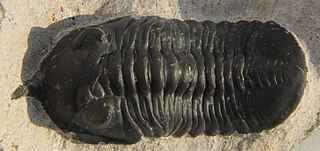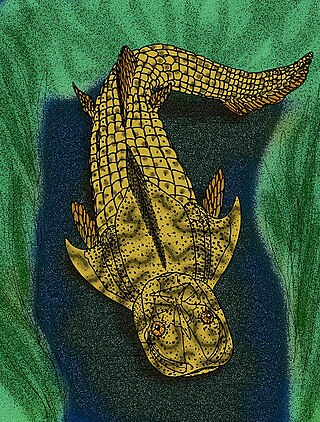Related Research Articles

Dalmanites is a genus of trilobite in the order Phacopida. They lived from the Late Ordovician to Middle Devonian.
A fenestra is any small opening or pore, commonly used as a term in the biological sciences. It is the Latin word for "window", and is used in various fields to describe a pore in an anatomical structure.

The Hunsrück Slate is a Lower Devonian lithostratigraphic unit, a type of rock strata, in the German regions of the Hunsrück and Taunus. It is a lagerstätte famous for exceptional preservation of a highly diverse fossil fauna assemblage.

The Emsian is one of three faunal stages in the Early Devonian Epoch. It lasted from 407.6 ± 2.6 million years ago to 393.3 ± 1.2 million years ago. It was preceded by the Pragian Stage and followed by the Eifelian Stage. It is named after the Ems river in Germany. The GSSP is located in the Zinzil'ban Gorge in the Kitab State Geological Reserve of Uzbekistan, 35 centimetres (14 in) above the contact with the Madmon Formation.
The Pragian is one of three faunal stages in the Early Devonian Epoch. It lasted from 410.8 ± 2.8 million years ago to 407.6 ± 2.8 million years ago. It was preceded by the Lochkovian Stage and followed by the Emsian Stage. The most important Lagerstätte of the Pragian is Rhynie chert in Scotland. It is named after the city of Prague. The GSSP is located within the Prague Formation at Velká Chuchle, Prague.

The Early Devonian is the first of three epochs comprising the Devonian period, corresponding to the Lower Devonian series. It lasted from 419.2 ± 3.2 to 393.3 ± 1.2 and began with the Lochkovian Stage 419.2 ± 3.2 to 410.8 ± 1.2, which was followed by the Pragian from 410.8 ± 3.2 to 407.6 ± 1.2 and then by the Emsian, which lasted until the Middle Devonian began, 393.3± 1.2 million years ago. During this time, the first ammonoids appeared, descending from bactritoid nautiloids. Ammonoids during this time period were simple and differed little from their nautiloid counterparts. These ammonoids belong to the order Agoniatitida, which in later epochs evolved to new ammonoid orders, for example Goniatitida and Clymeniida. This class of cephalopod molluscs would dominate the marine fauna until the beginning of the Mesozoic Era.
Eldredgeia is a genus of trilobites in the order Phacopida, suborder Phacopina, family Calmoniidae. This genus comes from the Devonian of South America and South Africa, usually found in nodules. The trilobite Eldredgeia venusta, from Bolivia, is the most common South American trilobite on today's fossil market, and even then it is not all that common. This genus has a spiny pygidium and usually the eye facets are well preserved.

Chotecops is a genus of trilobites from the order Phacopida, suborder Phacopina, family Phacopidae. It was initially erected as a subgenus of Phacops but some later authors thought it distinctive enough to raise its status. Species assigned to this genus occur between the Emsian and the Famennian. Chotecops is the most abundant trilobite in the Hunsrück Slate and due to the excellent preservation, often soft tissue such as antennae and legs have been preserved as a thin sheet of pyrite.

Erbenochile is a genus of spinose phacopid trilobite, of the family Acastidae, found in Lower to Middle Devonian age rocks from Algeria and Morocco. Originally described from an isolated pygidium, the first complete articulated specimen of E. erbeni revealed the presence of extraordinarily tall eyes:
"Straight-sided towers of lenses... with [up to] 18 lenses in a vertical file"
Acastava is an extinct genus of trilobite in the order Phacopida, from the upper Pragian to Emsian period of the Devonian.

Asteropyge is an extinct genus of trilobite. It lived from the end of the Lower Devonian into the Middle Devonian, in what are today France, Germany and Iran.
Tarijactinoides is a genus of trilobites in the order Phacopida, which existed in what is now Bolivia. It was described by Suárez Soruco in 1971, and the type species is Tarijactinoides jarcasensis.

Aleosteus is an extinct monospecific genus of arthrodire placoderm fish of the Early Devonian period. The type species Aleosteus eganensis was described in 2000, and was found in the Late Emsian strate of the Sevy Dolomite Formation, in the Egan Range of east-central Nevada, USA. Almost complete fossils belong to juvenile and adult specimens and show a short and broad skull, posteriorly concave.

Agoniatitida, also known as the Anarcestida, is the ancestral order within the cephalopod subclass Ammonoidea originating from bactritoid nautiloids, that lived in what would become Africa, Asia, Australia, Europe, and North America during the Devonian from about the lower boundary of Zlichovian stage into Taghanic event during upper middle Givetian, existing for approximately 25 million years.

Morocconites malladoides is an average size trilobite, which lived during the Devonian period, in what is now southern Morocco. This species is assumed to be a close relative of Acastoides. The most conspicuous feature is the very long upcurved frontal medial spine, a bit like an avocet bill. It is the only known species in this genus.

Yiminaspis is an extinct monospecific genus of primitive arthrodire placoderm fish from Emsian-aged marine strata in Yunnan, China. The type species Yiminaspis shenme was named and described in 2008, and is known from a flattened partial skull and portions of the thoracic armor.

Hollardops is a genus of trilobite in the order Phacopida that lived during the Devonian. Their fossils are found in the upper Emsian of western Europe and in the lower Emsian to lowermost Eifelian of North Africa. The type species, Asteropyge mesocristata, was described from Algeria by Le Maître in 1952. The genus Hollardops was erected by Morzadec in 1997. In the same year, Lieberman & Kloc erected Modellops and Philipsmithiana but those genera are regarded as subjective synonyms of Hollardops. The 10-segmented thoracic condition of Hollardops is a rare feature among acastid trilobites that almost always have 11 thorax segments. Van Viersen & Kloc (2022) revisited Hollardops and described a number of new species from the Devonian of Morocco. They also regarded Pennarbedops Bignon & Crônier, 2013 as a synonym of Hollardops. Van Viersen & Kloc construed Hollardops as a scavenger or predator with well-developed eyes, that used its shovel-like cephalon to plough the top layers of the sediment in search of food. Hollardops had small pits horizontally along the fringe of the exoskeleton; these are believed to have housed setae that allowed the trilobite to closely monitor its surroundings.
The Catavi Formation is a Pridoli to Emsian geologic formation of northern and central Bolivia. The formation comprises a 456 m (1,496 ft) thick succession of fine-grained, olive to brown sandstones and siltstones, shales and black limestones deposited in a shallow to deep marine environment.
The Gamoneda Formation is an Emsian geologic formation of southern Bolivia. The approximately 340 metres (1,120 ft) thick formation comprises marine micaceous grey siltstones and burrowed grey sandstones and shales.
The Cordobés Formation is an Early Devonian geologic formation of the Durazno Group in the Paraná Basin in the Durazno Department of central Uruguay. The shallow marine shales preserve trilobite, bivalve, gastropod and brachiopod fossils.
References
- 1 2 3 David J. Holloway & Maria da Gloria Pires de Carvalho (2009). "The extraordinary trilobite Fenestraspis (Dalmanitidae, Synphoriinae) from the Lower Devonian of Bolivia". Palaeontology . 52 (4): 933–949. Bibcode:2009Palgy..52..933H. doi: 10.1111/j.1475-4983.2009.00878.x .